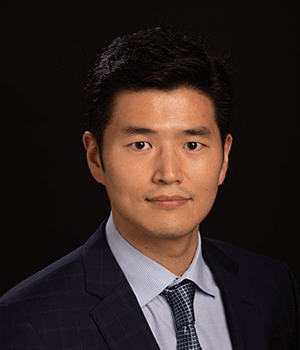
- chanyeop@uwm.edu
- Engineering & Mathematical Sciences USRB 201Q
- https://sites.google.com/view/chanyeop
Chanyeop Park
- Assistant Professor, Electrical Engineering
- Lab Director, Dielectric Resiliency & Electrical Aging Mitigation (DREAM) Lab
Chanyeop Park is an Assistant Professor of Electrical Engineering at the University of Wisconsin-Milwaukee. He was an Assistant Professor of Electrical and Computer Engineering and the Research Director of the Paul B. Jacob High Voltage Laboratory at Mississippi State University from 2019 – 2022. Dr. Park’s research identifies, characterizes, and addresses existing and emerging dielectric challenges in advanced power and energy technologies. His research interests include partial discharge, electrets, nonlinear electric field grading materials, soft electronic materials, lightning resistant materials, cryogenics, low-temperature plasma, applied superconductivity, and switchgear.
Education
- Postdoc, ECE, Georgia Tech, Atlanta, GA, 2018 - 2019
- PhD, ECE, Georgia Tech, Atlanta, GA, 2018
- MS, EE, Hanyang University, Seoul, South Korea, 2013
- BS, EE, Hanyang University, Seoul, South Korea, 2011
Research Interests
- Power Electronic Packaging
- Soft Electronics
- Switchgear
- Partial Discharge
- Space Charge
- Electret
- Composite
- Supercritical Fluid
Selected Publications
- R. E. Calabrese, E. Bury, F. Haque, A. Koh, and C. Park, “Effects of filler composition, loading, and geometry on the dielectric loss, partial discharge, and dielectric strength of liquid metal polymer composites,” Composites Part B: Engineering, vol. 234, p. 109686, Apr. 2022, doi: 10.1016/j.compositesb.2022.109686.
- F. Haque, O. Faruqe, and C. Park, “Effects of Fabrication Conditions on the Partial Discharge Mitigation Performance of Electrets for Power Electronic Driven Systems,” IEEE Transactions on Industrial Electronics, pp. 1–11, 2022, doi: 10.1109/TIE.2022.3183282.
- C. Park, “Electrets: A Remedy for Partial Discharge Caused by Power Electronics Switching,” IEEE Transactions on Industrial Electronics, vol. 68, no. 12, pp. 12947–12952, Dec. 2021, doi: 10.1109/TIE.2020.3045707.
- K. Yousefpour, M. Rostaghi-Chalaki, J. Warden, D. Wallace, and C. Park, “Design and Construction of an Impulse Current Generator for Lightning Strike Experiments,” International Journal of Electrical and Computer Engineering, vol. 15, no. 11, pp. 372–375, Nov. 2021.
- V. Kumar et al., “MXene Reinforced Thermosetting Composite for Lightning Strike Protection of Carbon Fiber Reinforced Polymer,” Adv. Mater. Interfaces, p. 2100803, Aug. 2021, doi: 10.1002/admi.202100803.
- M. Rostaghi-Chalaki, K. Yousefpour, J. Klüss, M. Kurum, J. P. Donohoe, and C. Park, “Classification and comparison of AC and DC partial discharges by pulse waveform analysis,” International Journal of Electrical Power & Energy Systems, vol. 125, p. 106518, Feb. 2021, doi: 10.1016/j.ijepes.2020.106518.
- F. Haque, J. (魏嘉) Wei, A. Cruz, L. Graber, and C. (박찬엽) Park, “Modeling cluster formation driven variations in critical electric field of He and Xe near critical point based on electron scattering cross sections,” Physics of Fluids, vol. 32, no. 12, p. 127106, Dec. 2020, doi: 10.1063/5.0028601.
- M. Rostaghi-Chalaki, K. Yousefpour, J. P. Donohoe, M. Kurum, C. Park, and J. Kluss, “Design of Transmission Line and Electromagnetic Field Sensors for DC Partial Discharge Analysis,” IEEE Trans. Dielect. Electr. Insul., vol. 27, no. 6, pp. 2138–2146, Dec. 2020, doi: 10.1109/TDEI.2020.009003.
- K. Yousefpour, W. Lin, Y. Wang, and C. Park, “Discharge and ground electrode design considerations for the lightning strike damage tolerance assessment of CFRP matrix composite laminates,” Composites Part B: Engineering, vol. 198, p. 108226, Oct. 2020, doi: 10.1016/j.compositesb.2020.108226.
- F. Haque, J. (魏嘉) Wei, L. Graber, and C. Park, “Modeling the dielectric strength variation of supercritical fluids driven by cluster formation near critical point,” Physics of Fluids, vol. 32, no. 7, p. 077101, Jul. 2020, doi: 10.1063/5.0008848.
- C. Park, “Electret: An Entirely New Approach of Solving Partial Discharge Caused by Triple Points, Sharp Edges, Bubbles, and Airgaps,” IEEE Access, vol. 8, pp. 78354–78366, 2020, doi: 10.1109/ACCESS.2020.2990310.